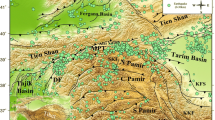Abstract
The postseismic lithospheric deformation is usually explained as viscoelastic relaxation of the coseismic stresses. In general, for computing the postseismic deformation, the shear modulus (μ) is relaxed, keeping either the bulk modulus (k) or the La’me parameter (A) fixed. It is shown that the two assumptions yield significantly different results. The assumptionk = const. implies that the medium behaves like an elastic body for dilatational changes which can be justified on physical grounds, but such a justification cannot be given in the case of the assumption λ = const.
Similar content being viewed by others
References
Bonafede M, Dragoni M and Quareni F 1986 Displacement and stress fields produced by a centre of dilation and by a pressure source in a viscoelastic half-space;Geophys. J. R. Astron. Soc. 87 455–485
Cohen S C 1980 Postseismic viscoelastic surface deformation and stress-1. Theoretical considerations, displacement and strain calculations;J. Geophys. Res. 85 3131–3150
Cohen S C 1982 A multilayer model of time dependent deformation following an earthquake on a strike slip fault;J. Geophys. Res. 87 5409–5421
Dragoni M and Magnanensi C 1989 Displacement and stress produced by a pressurized, spherical magma chamber, surrounded by a viscoelastic shell;Phys. Earth Planet. Int. 56 316–328
Iwasaki T 1985 Quasi-static deformation due to a dislocation source in a Maxwellian viscoelastic earth model;J. Phys. Earth 33 21–43
Iwasaki T 1986 Displacement, strain and stress within a viscoelastic half-space due to a rectangular fault;J. Phys. Earth 34 371–396
Iwasaki T and Matsu’ura M 1981 Quasi-static strains and tilts due to faulting in a layered half-space with an intervenient viscoelastic layer;J. Phys. Earth 29 499–518
Iwasaki T and Matsu’ura M 1982 Quasi-static crustal deformations due to a surface load; Rheological structure of the earth’s crust and upper mantle;J. Phys. Earth 30 469–508
Ma X Q and Kusznir N J 1994a Effects of rigidity layering, gravity and stress relaxation on 3-D subsurface fault displacement fields;Geophys. J. Int. 118 201–220
Ma X Q and Kusznir N J 1994b Coseismic and postseismic subsurface displacements and strains for a vertical strike-slip fault in a three-layer elastic medium;Pure Appl. Geophys. 142 687–709
Ma X Q and Kusznir N J 1995 Coseismic and postseismic subsurface displacements and strains for a dip-slip normal fault in a three-layer elastic-gravitational medium;J. Geophys. Res. 100 12, 813–12, 828
Malosh H J and Raefsky A 1983 An elastic response of the Earth to a dip-slip earthquake;J. Geophys. Res. 88 515–526
Matsu’ura M and Tanimoto T 1980 Quasi-static deformations due to an inclined rectangular fault in a viscoelastic halfspace;J. Phys. Earth 28 103–118
Matsu’ura M, Tanimoto T and Iwasaki T 1981 Quasi-static displacements due to faulting in a layered half-space with an intervenient viscoelastic layer;J. Phys. Earth 29 23–54
Nur A and Mavko G 1974 Postseismic viscoelastic rebound;Science 183 204–206
Peltier W R 1974 The impulse response of a Maxwell earth;Rev. Geophys. Space Phys. 12 649–669
Pollitz F F 1992 Postseismic relaxation theory on the spherical Earth;Bull. Seismol. Soc. Am. 82 422–453
Rosenman M and Singh S J 1973a Quasi-static strains and tilts due to faulting in a viscoelastic half-space;Bull. Seismol. Soc. Am. 63 1737–1752
Rosenman M and Singh S J 1973b Stress relaxation in a semiinfinite viscoelastic Earth model;Bull. Seismol. Soc. Am. 63 2145–2154
Rundle J B 1978 Viscoelastic crustal deformation by finite quasi-static sources;J. Geophys. Res. 83 5937–5945
Rundle J B 1982 Viscoelastic-gravitational deformation by a rectangular thrust fault in a layered earth;J. Geophys. Res. 87 7787–7796
Rundle J B and Jackson D D 1977 A three-dimensional viscoelastic model of a strike-slip fault;Geophys. J. R. Astron. Soc. 49 575–591
Singh K and Singh S J 1990 A simple procedure for obtaining the quasi-static displacements, strains, and stresses in a viscoelastic half-space;Bull. Seismol. Soc. Am. 80 488–492
Singh S J and Rosenman M 1974 Quasi-static deformation of a viscoelastic half-space by a displacement dislocation;Phys. Earth Planet. Int. 8 87–101
Thatcher W and Rundle J B 1979 A model for the earthquake cycle in under thrust zones;J. Geophys. Res. 84 5540–5556
Author information
Authors and Affiliations
Rights and permissions
About this article
Cite this article
Singh, S.J., Singh, M. & Singh, K. A note on the assumptions made while computing the postseismic lithospheric deformation. Proc. Indian Acad. Sci. (Earth Planet Sci.) 106, 9–14 (1997). https://doi.org/10.1007/BF02841746
Received:
Revised:
Published:
Issue Date:
DOI: https://doi.org/10.1007/BF02841746




